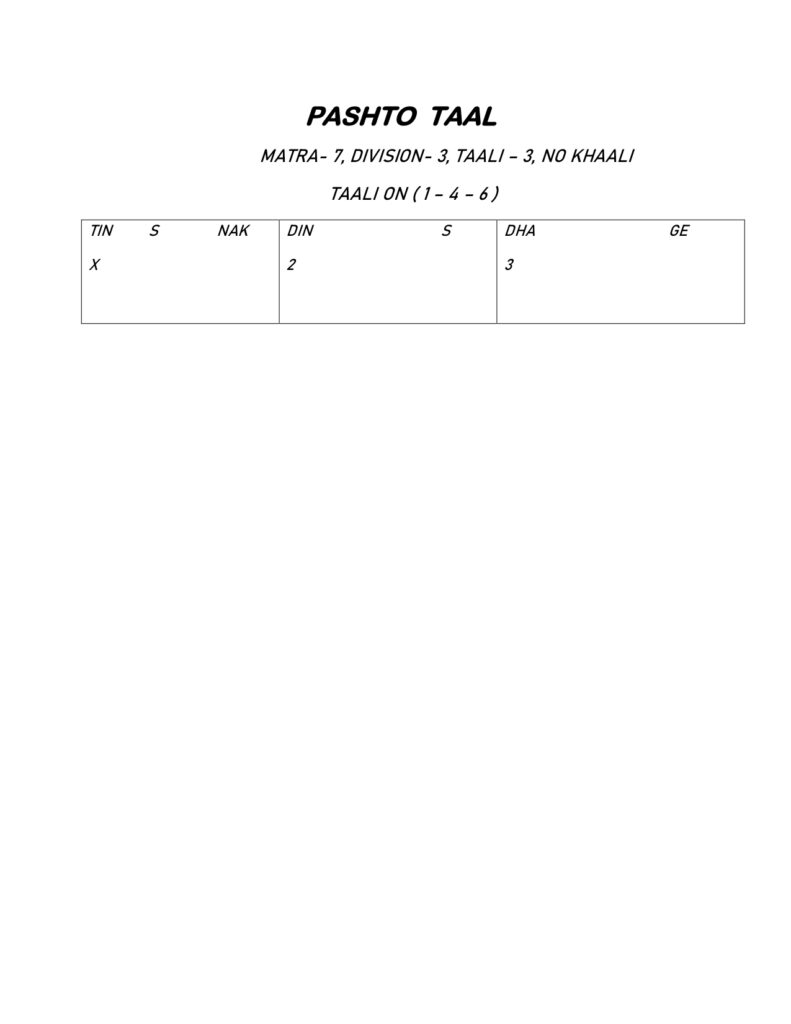#Pashto Taal Theka Pashto Taal is a rhythmic cycle commonly used in Indian classical music, particularly in the tabla repertoire. It consists of 7 beats, divided into 3 divisions (vibhag), with three Taali (claps) and no Khaali (no wave or rest).
Introducing the-

https://www.youtube.com/@BhagawanSingh
Pashto Taal is a relatively lesser-known rhythmic cycle in Indian classical music but holds significance in tabla compositions and certain folk or semi-classical genres. It is unique due to its 7-beat structure and the absence of Khaali (empty beat), making it a lively and energetic taal.
Detailed Structure of Pashto Taal:
- Matra (Beats): 7
- Divisions (Vibhag): 3 divisions
- The divisions help organize the beat cycle and allow performers to maintain rhythmic clarity. In this taal, the division is irregular, adding complexity to its structure.
- Division 1: 3 beats (Taali on beat 1)
- Division 2: 2 beats (Taali on beat 4)
- Division 3: 2 beats (Taali on beat 6)
- Taali (Claps): 3 (on beats 1, 4, and 6)
- Taali refers to the claps or accented beats that mark the divisions within the taal. In Pashto Taal, there are claps on three different beats (1, 4, and 6), giving it a strong sense of structure and making it distinct from other taals with Khaali.
- No Khaali (No Rest/Wave):
- In contrast to many other taals like Teentaal or Rupak, which have both Taali and Khaali, Pashto Taal has no Khaali (no wave or rest). This means that each beat is accentuated, leading to a continuous, flowing rhythm with no pause.
Theka (Basic Pattern) of Pashto Taal:
The theka is the basic syllabic pattern played on the tabla to define the taal. For Pashto Taal, a common theka might look like this:
Dha Dhin Dha | Dha Tin | Ta Tin
This theka demonstrates the rhythm, with each syllable corresponding to a specific hand movement on the tabla.
Characteristics:
- Odd Beat Cycle: With 7 beats, Pashto Taal stands out because most commonly used taals, such as Teentaal or Dadra, have even numbers of beats (e.g., 16, 8, or 6).
- Syncopation: Due to its uneven divisions (3+2+2), the taal has a syncopated feel, which challenges musicians to keep their timing precise. This makes it ideal for dynamic and expressive performances.
- Usage in Music:
- Folk and Semi-Classical Music: Pashto Taal is often used in folk music or semi-classical genres, such as light classical compositions, bhajans, or ghazals.
- Dance: The rhythmic complexity and energy of the taal make it suitable for dance performances, particularly those with improvisational elements.
- Performance Style: The accentuation of all beats (no Khaali) makes Pashto Taal more forceful and driving compared to other taals with rests, such as Rupak or Jhaptaal. It demands skillful execution from the tabla player, who must balance the rhythm’s complexity while maintaining clarity.
Applications:
- Tabla solos often feature this taal, where the tabla player showcases their command over intricate rhythm patterns.
- Accompaniment in classical performances, especially for light classical songs or specific instrumental pieces that require a lively rhythm.
Variations:
While the traditional Pashto Taal has no Khaali and is defined by its Taali on beats 1, 4, and 6, variations may exist in different gharanas (schools of music) where different thekas or ornamentations are applied to add flavor to the composition.
Conclusion:
Pashto Taal’s unique 7-beat cycle, combined with its no Khaali and three Taali structure, makes it a dynamic and energetic taal suited for expressive performances. Its syncopated rhythm and lively flow offer a challenge for musicians and dancers alike, allowing for creativity and improvisation.

